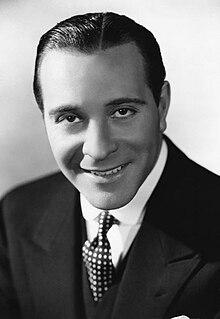|
Ricardo Cortez
Ricardo Cortez (born Jacob Kranze[1][2][3] or Jacob Krantz;[4] September 19, 1900 – April 28, 1977) was an American actor and film director. He was also credited as Jack Crane early in his acting career.[3][5] Early yearsRicardo Cortez was born Jacob Kranze or Krantz in New York City to Jewish parents, Sarah (née Lefkovitz) and Morris Kranze or Krantz.[6] He had a brother Stanley Cortez (né Stanislaus Kranze or Krantz).[7] (Vienna has been incorrectly cited as his birthplace.)[note 1][7][8] He attended DeWitt Clinton High School in New York City.[2][9][10] Prior to entering the film business, he was an amateur boxer and worked on Wall Street as a runner.[3] Film careerActingHollywood executives changed his name from Krantz to Cortez to capitalize on his handsome Latin-like features and the popularity of the silent film era's "Latin lovers" such as Rudolph Valentino, Ramon Novarro and Antonio Moreno. When it began to circulate publicly that Cortez was not actually Latin, the studios attempted to pass him off as French before a final Viennese origin story was promoted.[citation needed] Cortez appeared in over 100 films. He began his career playing romantic leads, and when sound cinema arrived, his strong delivery and New York accent made him an ideal heavy. While his main focus was character acting, he occasionally was able to play leading men. He played opposite Joan Crawford in Montana Moon (1930), and was the first actor to portray Sam Spade in the original pre-Code version of The Maltese Falcon (1931); the latter film was later overshaded by the 1941 remake with Humphrey Bogart in the lead. He co-starred with Charles Farrell and Bette Davis in The Big Shakedown (1934), and with Al Jolson and Dolores del Río in Wonder Bar (1934). In 1936, Cortez replaced Warren William as Perry Mason in The Case of the Black Cat. Directing Cortez directed seven films for 20th Century Fox from 1938 through 1940, all of them "program pictures made on a shoestring for the express purpose of filling the bottom half of the mandatory double bill ..."[11] His first film as director was Inside Story, which was assigned to Cortez in the spring of 1938 but was not released until 1939. He also directed Chasing Danger, The Escape (1939), Heaven with a Barbed Wire Fence (1939), City of Chance (1940), Free, Blonde and 21 (1940), and Girl in 313 (1940).[11] Personal lifeCortez married silent film actress Alma Rubens on February 8, 1926. They had previously married on January 30, but it was invalid due to Rubens's divorce not being finalized. The couple separated in 1930, and she had sued him for divorce when she died of pneumonia on January 21, 1931.[11][12] Cortez married Christine Conniff Lee on January 8, 1934, but they divorced in 1940.[citation needed] After retiring from the film business in the late 1950s, Cortez returned to New York, and began working as a stockbroker for Salomon Brothers on Wall Street.[citation needed] DeathCortez died in Doctors Hospital in New York City in 1977 at age 76[8] and was interred at Woodlawn Cemetery in the Bronx.[citation needed] RecognitionCortez has a star at 1500 Vine Street in the Motion Pictures section of the Hollywood Walk of Fame. It was dedicated on February 8, 1960.[13] Filmography 
Notes
References
Bibliography
External linksWikimedia Commons has media related to Ricardo Cortez. |
||||||||||||||||||||
